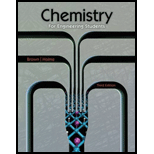
Concept explainers
Interpretation:
Explanation should be given for using SiO2 as a mask instead of the fact that it will react with the etchant.
Concept introduction:
Microfabrication is a process through which nearly all the semiconductor type materials and circuits are fabricated. The microfabricated devices are formed over the substrate surface with one or more thin films. In most of the devices, silicon wafers are generally used as substrate.
The insertion of desirable pattern is done through masking in which a certain portion of the film is detected which is to be removed for insertion.
Etching is the process of removing a small portion of that thin film or substrate from the device.
This etching can be of two types; dry etching (plasma etching) or wet etching (chemical etching).
Want to see the full answer?
Check out a sample textbook solution
Chapter 8 Solutions
Chemistry for Engineering Students
- The precious metal platinum was first used by indigenous peoples of South America, who found impure, native samples of it in the Au mines of what is now Ecuador and used the samples to make small items of jewelry. Platinum’s high melting point (1772oC) makes it harder to work than Au (1064oC) and Ag (962oC), but this same property and a high resistance to chemical attack make Pt suitable as a material for high-temperature crucibles. Although Pt is a noble metal, in the +4 and +2 states it forms a variety of compounds, many of which are coordination complexes. Its coordinating abilities make it an important catalyst for organic and inorganic reactions. Draw coordination complex trans-Platinum diammine dichloride and label the Pt with its oxidation number. For Pt4+, draw energy level diagrams of the d-AOs and show orbital occupancy in both weak and strong octahedral fields. Calculate the total spin for each case. Calculate the CFSE (crystal field stabilization energy) in terms of Δ0 for…arrow_forwardThe precious metal platinum was first used by indigenous peoples of South America, who found impure, native samples of it in the Au mines of what is now Ecuador and used the samples to make small items of jewelry. Platinum’s high melting point (1772oC) makes it harder to work than Au (1064oC) and Ag (962oC), but this same property and a high resistance to chemical attack make Pt suitable as a material for high-temperature crucibles. Although Pt is a noble metal, in the +4 and +2 states it forms a variety of compounds, many of which are coordination complexes. Its coordinating abilities make it an important catalyst for organic and inorganic reactions. The anticancer cisplatin (mentioned during lectures) can be prepared from K2PtCl6 via reduction with hydrazine (N2H4), giving K2PtCl4, followed by replacement of the 2 Cl ion ligands with NH3. Give the names to the three platinum compounds referred to. Draw coordination complex trans-Platinum diammine dichloride and label the Pt with its…arrow_forwardIs the reaction of rubidium with water more or less vigorous than that of sodium? How does the rate of reaction of magnesium compare?arrow_forward
- Why is SnCl4 not classified as a salt?arrow_forwardWrite a balanced equation for the reaction of elemental strontium with each of the following: (a) oxygen (b) hydrogen bromide (c) hydrogen (d) phosphorus (e) waterarrow_forwardWhile selenic acid has the formula H2SeO4 and thus is directly related to sulfuric acid, telluric acid is best visualized as H6TeO6 or Te(OH)6? a. What is the oxidation state of tellurium in Te(OH)6? b. Despite its structural differences with sulfuric and selenic acid, telluric acid is a diprotic acid with pKa1=7.68 and pKa2=11.29. Telluric add can be prepared by hydrolysis of tellurium hexafluoride according to the equation TeF6(g)+6H2O(l)Te(OH)6(aq)+6HF(aq) Tellurium hexafluoride can be prepared by the reaction of elemental tellurium with fluorine gas: Te(s)+3F2(g)TeF6(g) If a cubic block of tellurium (density = 6.240 g/cm3) measuring 0.545 cm on edge is allowed to react with 2.34 L fluorine gas at 1.06 atm and 25C, what is the pH of a solution of Te(OH)6 formed by dissolving the isolated TeF6(g) in 115 mL solution? Assume 100% yield in all reactions.arrow_forward
 Chemistry & Chemical ReactivityChemistryISBN:9781337399074Author:John C. Kotz, Paul M. Treichel, John Townsend, David TreichelPublisher:Cengage Learning
Chemistry & Chemical ReactivityChemistryISBN:9781337399074Author:John C. Kotz, Paul M. Treichel, John Townsend, David TreichelPublisher:Cengage Learning Chemistry & Chemical ReactivityChemistryISBN:9781133949640Author:John C. Kotz, Paul M. Treichel, John Townsend, David TreichelPublisher:Cengage Learning
Chemistry & Chemical ReactivityChemistryISBN:9781133949640Author:John C. Kotz, Paul M. Treichel, John Townsend, David TreichelPublisher:Cengage Learning
 Chemistry: An Atoms First ApproachChemistryISBN:9781305079243Author:Steven S. Zumdahl, Susan A. ZumdahlPublisher:Cengage Learning
Chemistry: An Atoms First ApproachChemistryISBN:9781305079243Author:Steven S. Zumdahl, Susan A. ZumdahlPublisher:Cengage Learning ChemistryChemistryISBN:9781305957404Author:Steven S. Zumdahl, Susan A. Zumdahl, Donald J. DeCostePublisher:Cengage Learning
ChemistryChemistryISBN:9781305957404Author:Steven S. Zumdahl, Susan A. Zumdahl, Donald J. DeCostePublisher:Cengage Learning Chemistry by OpenStax (2015-05-04)ChemistryISBN:9781938168390Author:Klaus Theopold, Richard H Langley, Paul Flowers, William R. Robinson, Mark BlaserPublisher:OpenStax
Chemistry by OpenStax (2015-05-04)ChemistryISBN:9781938168390Author:Klaus Theopold, Richard H Langley, Paul Flowers, William R. Robinson, Mark BlaserPublisher:OpenStax





